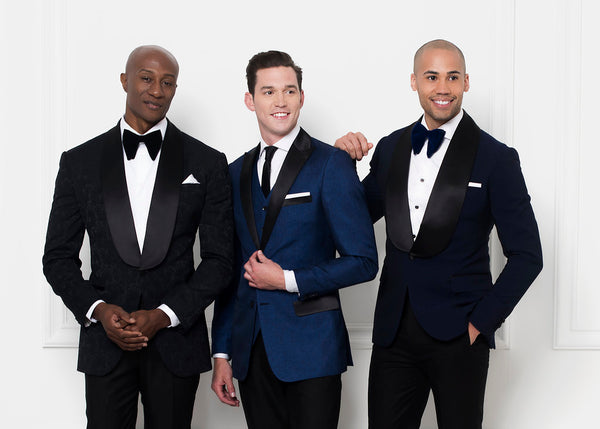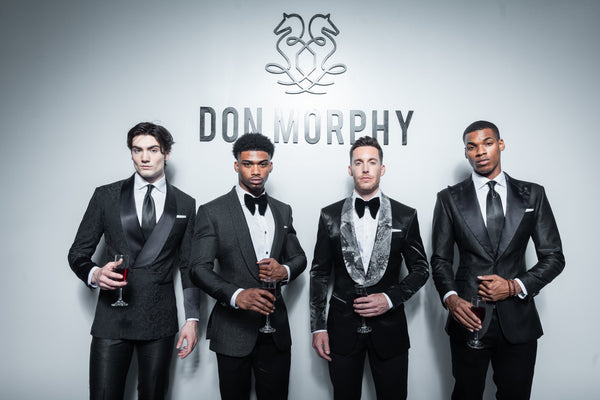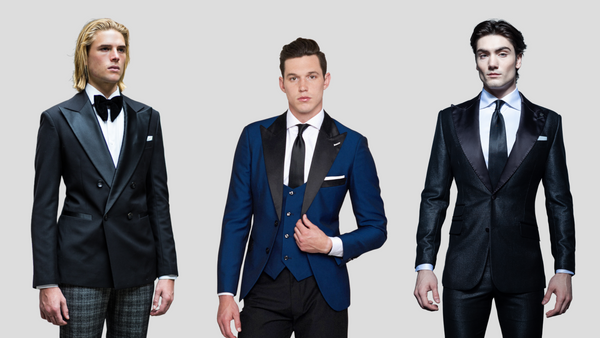
Tuxedo vs Suit: Breaking Down Their Unique Features
What sets apart a suit from a tuxedo? While they may look similar and people often use the terms interchangeably for the jacket and pants, the key difference lies in satin. When choosing your outfit, remember to pair it with affordable business dress shirts to keep your look stylish without breaking the bank. Let's explore the main distinctions between a tuxedo and a suit.
In this comprehensive guide, we will delve into the defining features, historical backgrounds, appropriate occasions, styling tips, common mistakes to avoid, and factors to consider when choosing between a tuxedo and a suit.
Defining Tuxedos and Suits
What is a Tuxedo?

A tuxedo, which people often call a "tux," is a fancy suit worn for evening events. It stands out because of its satin details. Typically, a tuxedo features satin or grosgrain facing on the lapels, buttons, pocket trim, and a stripe down the trousers. It is traditionally worn with a bow tie and may include a cummerbund or waistcoat. Tuxedos are associated with black-tie events and are considered more formal than suits. These features give tuxedos their distinctive and elegant appearance.
- Satin Accents: Tuxedos have shiny satin on the lapels, buttons, and a stripe down the pants.
- Bow Tie: They are typically paired with a bow tie, adding to their formal appeal.
- Formal Shirts: Tuxedos are worn with formal shirts that often include pleats or a wingtip collar.
- Special Occasions: Perfect for black-tie events, weddings, and other highly formal gatherings.
What is a Suit?

A suit is a two or three-piece ensemble consisting of a jacket and trousers made from the same fabric. Suits come in various styles and colors and are generally less adorned compared to tuxedos. They are versatile and can be worn for a wide range of occasions, from business meetings to semi-formal events. Suits are typically paired with a dress shirt, necktie or bow tie, and dress shoes.
- Fabric and Construction: Suits have lapels, buttons, and trousers all made from the same material, without the shiny satin details found in tuxedos.
- Necktie or Bow Tie: Can be worn with either a necktie or a bow tie, depending on the desired level of formality.
- Shirt Options: You can pair it with anything from crisp formal dress shirts to more laid-back, casual choices.
- Everyday Wear: Ideal for business meetings, professional settings, semi-formal events, and casual occasions.
Historical Background
The Evolution of the Tuxedo
The tuxedo has a rich history dating back to the 19th century. It was first introduced in the 1860s by the Prince of Wales (later King Edward VII) as a more comfortable choice for formal evening wear.
- 19th Century Beginnings: The tuxedo gained popularity in America in the late 1800s. It was named after Tuxedo Park, a New York country club where it was first worn.
- Evolution Over Time: The tuxedo has evolved with different styles and cuts but continues to symbolize elegance and formality.
The History of the Suit
The suit carries a fascinating history that stretches back to the 17th century, shaped by changing styles and cultural shifts.
- 17th Century Roots: The roots of the modern suit can be traced to the court of King Charles II of England, where the concept of a coordinated three-piece ensemble began to take shape.
- Industrial Revolution Impact: The 19th century marked a turning point with the mass production of suits, democratizing access to stylish attire.
- Rise to Professionalism: By the 20th century, suits had become synonymous with professionalism and business attire. They evolved into a symbol of sophistication and versatility.
- Contemporary Diversity: Today, suits come in an array of styles, fabrics, and cuts to cater to diverse tastes and occasions, ensuring there's a perfect fit for every wardrobe.
Design and Fabric Differences
Jacket Lapels: Satin vs Fabric
One of the standout contrasts between a tuxedo and a suit can be found in their jacket lapels. Tuxedos boast satin lapels that lend an air of sophistication and formality. These satin accents, often in classic black, can also create a striking visual contrast. In contrast, suit lapels are crafted from the same fabric as the jacket, resulting in a cohesive and adaptable appearance.
Trousers: Stripes vs Plain
Tuxedo trousers stand out with a sleek satin stripe running along the outer seam, perfectly complementing the satin features of the jacket to elevate its formal charm. In contrast, suit trousers are plain and lack this stripe, allowing them to effortlessly transition between formal and semi-formal occasions, highlighting their versatility.
Accessories: Bow Tie vs Necktie
Accessories are key in distinguishing between tuxedos and suits. Tuxedos traditionally feature a bow tie, symbolizing ultimate formal elegance. Suits, on the other hand, offer a choice between a bow tie or a necktie, providing versatility based on the event's formality. A suit's necktie can range from business professional to semi-formal, whereas a tuxedo's bow tie is reserved strictly for formal affairs.
Shirt Styles and Details
The differences in shirt styles between tuxedos and suits add another layer of distinction. Tuxedo shirts are classic in white, featuring wingtip collars that beautifully frame a bow tie. They boast French cuffs, perfect for showing off cufflinks, and sometimes include pleats for extra flair. In contrast, suit shirts offer a wider range of colors and patterns. They typically have standard collars and cuffs, making them versatile for various occasions and individual tastes.
When to Wear a Tuxedo
Formal Events and Black-Tie Affairs
Tuxedos are the ultimate pick for formal gatherings and black-tie affairs. These occasions set the bar high for dress codes, requiring an aura of elegance and refinement. A timeless tuxedo featuring satin lapels, a bow tie, and sleek black shoes is the epitome of sophistication, guaranteeing you make a flawless impression while staying true to the event's dress guidelines.
Weddings: Groom and Groomsmen Attire
When it comes to weddings, tuxedos are perfect for the groom and his groomsmen. They add an extra touch of elegance, ensuring the groom stands out while coordinating seamlessly with his wedding party. Whether it's a black-tie affair or a formal evening celebration, a tuxedo brings the necessary sophistication and charm, making the wedding day all the more unforgettable.
When to Wear a Suit
Business and Professional Settings
Suits are essential in business and professional environments. They strike a perfect balance between looking professional and stylish, making them ideal for offices, meetings, and business gatherings. A properly tailored suit in timeless colors such as navy, grey, or black conveys competence and ensures you appear confident in any professional setting.
Semi-Formal Events and Everyday Wear
Suits excel in versatility, whether for semi-formal occasions or daily wear. They effortlessly elevate with a tie and pocket square for events like cocktail parties or dial down with an open-collar shirt for a polished yet relaxed vibe. This flexibility ensures suits are a must-have in any closet, seamlessly transitioning from social gatherings to everyday professional attire.
Styling Tips for Tuxedos and Suits
Choosing the Right Fit
The right fit is crucial for both tuxedos and suits. A poorly fitting outfit can detract from even the most stylish appearance. When it comes to tuxedos, ensure the shoulders fit just right, the jacket drapes smoothly without tugging, and the trousers hang cleanly without gathering. With suits, a slim or tailored cut often works best, but always prioritize comfort and mobility.
Pro Tip: A visit to a skilled tailor can make minor adjustments that elevate your look from good to flawless.
Coordinating Colors and Patterns
Perfecting your skill in coordinating colors and patterns can take your style to new heights. With tuxedos, sticking to timeless black and white guarantees an enduring elegance. For a contemporary touch, explore a dark navy tuxedo with a subtle pattern.
When it comes to suits, experiment with a variety of colors and patterns. Try pairing a navy suit with a light blue shirt and a tastefully patterned tie for a refined appearance.
Tip: When combining patterns, ensure they vary in size. Pairing a bold plaid suit with a delicate striped tie can create a visually striking ensemble.
Common Mistakes to Avoid
Misunderstanding Dress Codes
Misinterpreting dress codes is a frequent pitfall. Tuxedos are usually reserved for black-tie affairs, whereas suits offer flexibility for different settings. Always review the event invitation to clarify the dress code.
Tip: If unsure, a dark suit is a safe choice. It's versatile and can often suitably fit into more formal occasions.
Overlooking Fit and Tailoring
Overlooking the fit and tailoring of your attire can be a critical oversight. Off-the-rack suits or tuxedos often need adjustments to achieve a flawless look. Ignoring this aspect can result in a less than polished appearance.
Tip: Invest in tailoring. Minor tweaks like sleeve adjustments or waist alterations can greatly enhance your overall appearance.
Factors to Consider
Event Formality
Tuxedos are best for formal events like black-tie affairs or weddings. Suits are more versatile and work well for different occasions, including business meetings and casual get-togethers.
Personal Style
Your own style and comfort matter most. If you like a traditional and enduring appearance, a tuxedo could be your choice. Alternatively, if you enjoy trying out different colors and patterns, a suit gives you more options.
Occasion Timing
The time of day can impact what you choose to wear.Tuxedos are traditionally reserved for evening events, while suits are suitable for both daytime and evening affairs depending on the dress code.
Dress Code
Always follow the dress code specified in the invitation. A "black-tie" event requires a tuxedo, while "black-tie optional" allows for a dark suit or tuxedo.



